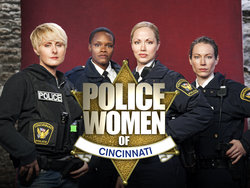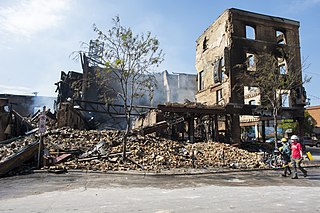Related Research Articles

The Hong Kong Police Force (HKPF) is the primary law enforcement, investigative agency, and largest disciplined service under the Security Bureau of Hong Kong.
The Fuhrman tapes are 13 hours of taped interviews given by Mark Fuhrman, former detective of the Los Angeles Police Department, to writer Laura McKinny between 1985 and 1994.

The Minneapolis Police Department (MPD) is the primary law enforcement agency in Minneapolis, Minnesota, United States. It is also the largest police department in Minnesota. Formed in 1867, it is the second-oldest police department in Minnesota, after the Saint Paul Police Department that formed in 1854. A short-lived Board of Police Commissioners existed from 1887 to 1890.
Anthony Vila Bouza was an American police officer who served in the New York City Police Department and as police chief of the Minneapolis Police Department from 1980 to 1989.
Yvonne Welbon is an American independent film director, producer, and screenwriter based in Chicago. She is known for her films, Living with Pride:Ruth C. Ellis @ 100 (1999), Sisters in Cinema (2003), and Monique (1992).

Police Women of Cincinnati is the fifth installment of TLC's Police Women reality documentary series, which follows four female members of the Cincinnati Police Department (CPD) in Cincinnati, Ohio.

The integration of women into law enforcement positions can be considered a large social change. A century ago, there were few jobs open to women in law enforcement. A small number of women worked as correctional officers, and their assignments were usually limited to peripheral tasks. Women traditionally worked in juvenile facilities, handled crimes involving female offenders, or performed clerical tasks. In these early days, women were not considered as capable as men in law enforcement. Recently, many options have opened up, creating new possible careers.

On November 15, 2015, two police officers fatally shot Jamar Clark, a 24-year-old African-American man, in Minneapolis. The two shooters were Mark Ringgenberg and Dustin Schwarze. They were a part of the Minneapolis Police Department which subsequently placed the men on paid administrative leave. The night after Ringgenberg and Schwarze shot him, Clark died at the Hennepin County Medical Center after being taken off life support. His death resulted from one of the gunshot wounds the shooters inflicted on November 15.
Women in policing in the United States, colloquially known as women police or female cop, began as early as the 1890s. Women make up 12.6% of all U.S. sworn police officers in 2018. Employed largely as prison matrons in the 19th century, women took on more and increasingly diverse roles in the latter half of the 20th century. They face a particular set of challenges given the history of their entry into the profession, their low rates of participation, and the complex identities they negotiate in the work place. Women who work in law enforcement have struggled for years to gain acceptance in their workplace. Some of their biggest challenges are their lack of representation, stereotypes around women, and intersectionality. Despite these challenges, women have proven to be more calm and use less force. Women go into situations more level-headed than males, and are able to deescalate situations better.

On July 15, 2017, Justine Damond, a 40-year-old Australian-American woman, was fatally shot by 31-year-old Somali-American Minneapolis Police Department officer Mohamed Noor after she had called 9-1-1 to report the possible assault of a woman in an alley behind her house. Occurring weeks after a high-profile manslaughter trial acquittal in the 2016 police killing of Philando Castile, also in the Minneapolis–Saint Paul metropolitan area, the shooting exacerbated existing tensions and attracted national and international press.

Medaria Arradondo is an American law enforcement official who served as the Chief of the Minneapolis Police Department from 2017 to 2022. He was the first black chief of the Minneapolis Police Department.

On May 25, 2020, George Floyd, a 46-year-old black American man, was murdered in Minneapolis by Derek Chauvin, a 44-year-old white police officer. Floyd had been arrested after a store clerk reported that he made a purchase using a counterfeit $20 bill. Chauvin knelt on Floyd's neck for over nine minutes while Floyd was handcuffed and lying face-down in a street. Two other police officers, J. Alexander Kueng and Thomas Lane, assisted Chauvin in restraining Floyd. Lane had also pointed a gun at Floyd's head before Floyd was handcuffed. A fourth police officer, Tou Thao, prevented bystanders from intervening.

The George Floyd protests were a series of riots and demonstrations against police brutality that began in Minneapolis in the United States on May 26, 2020. The protests and civil unrest began in Minneapolis as reactions to the murder of George Floyd, a 46-year-old unarmed African American man, by city police during an arrest. They spread nationally and internationally. Veteran officer Derek Chauvin was recorded as kneeling on Floyd's neck for 9 minutes and 29 seconds; Floyd complained of not being able to breathe, but three other officers looked on and prevented passersby from intervening. Chauvin and the other three officers involved were later arrested. In April 2021, Chauvin was found guilty of second-degree murder, third-degree murder, and second-degree manslaughter. In June 2021, Chauvin was sentenced to 22+1⁄2 years in prison.
The following is a timeline of race relations and policing in Minneapolis–Saint Paul, providing details with a history of policing in the Twin Cities in the U.S. state of Minnesota from the nineteenth century to the present day. The Hennepin County Sheriff's Office, with its headquarters in downtown Minneapolis, is one of the "largest law enforcement agencies in Minnesota" with division and unit facilities throughout Hennepin County. Twin cities, Saint Paul and Minneapolis, have their own police departments, the Minneapolis Police Department, which was established in 1867 and the Saint Paul Police Department. A union for rank and file officers in Minneapolis—the Police Officers Federation of Minneapolis —was established in 1917.

Local protests over the murder of George Floyd, sometimes called the Minneapolis riots or the Minneapolis uprising, began on May 26, 2020, and within a few days had inspired a global protest movement against police brutality and racial inequality. The initial events were a reaction to a video filmed the day before and circulated widely in the media of police officer Derek Chauvin kneeling on Floyd's neck for several minutes while Floyd struggled to breathe, begged for help, lost consciousness, and died. Public outrage over the content of the video gave way to widespread civil disorder in Minneapolis, Saint Paul, and other cities in the Minneapolis–Saint Paul metropolitan area over the five-day period of May 26 to 30 after Floyd's murder.

False rumors of a police shooting resulted in rioting, arson, and looting in the U.S. city of Minneapolis from August 26–28, 2020. The events began as a reaction to the suicide of Eddie Sole Jr., a 38-year old black man who was being pursued by Minneapolis police officers for his alleged involvement in a homicide. At approximately 2 p.m. on August 26, Sole died after he shot himself in the head as officers approached to arrest him. False rumors quickly spread on social media that Minneapolis police officers had fatally shot Sole. To quell unrest, Minneapolis police released closed-circuit television surveillance footage that captured Sole's suicide, which was later confirmed by a Hennepin County Medical Examiner's autopsy report.

The police abolition movement gained momentum in the U.S. city of Minneapolis during protests of the murder of George Floyd in 2020 and culminated in the failed Question 2 ballot measure in 2021 to replace the city's police department with a public safety department. The measure would have removed minimum staffing levels for sworn officers, renamed the Minneapolis Police Department as the Minneapolis Department of Public Safety, and shifted oversight of the new agency from the mayor's office to the city council. It required the support of 51 percent of voters in order to pass. In the Minneapolis municipal election held on November 2, 2021, the measure failed with 43.8 percent voting for it and 56.2 percent voting against it.

The aftermath of the George Floyd protests in Minneapolis–Saint Paul describes the result of civil disorder between May 26 and June 7, 2020, in the Twin Cities metropolitan area of the U.S. state of Minnesota. Protests began as a response to the murder of George Floyd, a 46-year-old African-American man on May 25, after Minneapolis police officer Derek Chauvin knelt on Floyd's neck for 9 minutes and 29 seconds as three other officers assisted during an arrest. The incident was captured on a bystander's video and it drew public outrage as video quickly circulated in the news media by the following day.
Darnella Frazier is an American woman who recorded the murder of George Floyd on May 25, 2020, posting her video on Facebook and Instagram. The video undermined the initial account of Floyd's death by the Minneapolis Police Department, and served as evidence leading to criminal charges against four police officers. Frazier testified during the trial, which ended with the conviction of Derek Chauvin on murder charges, and the convictions of the other three officers on manslaughter. She received a special award and citation from the Pulitzer Prize board in 2021.
References
- ↑ Louis, Pierre-Antoine (February 8, 2021). "'Women in Blue,' and Redefining What It Means to Protect and Serve" – via NYTimes.com.
- ↑ White, Sgt Alice; Department, Minneapolis Police. "Documentary Asks: Do 'Women In Blue' Police Differently Than Male Officers?". NPR.org.
- ↑ "New Documentary 'Women In Blue' Explores Intersection Of Gender And Race Within MPD". February 5, 2021.